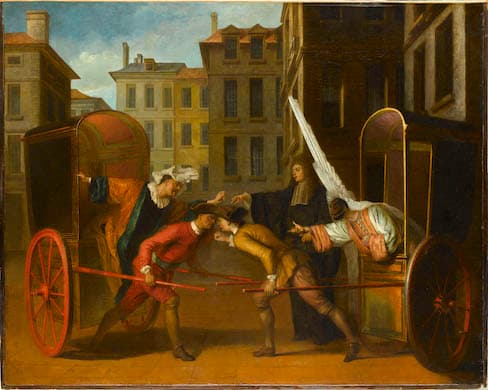Gillot’s ‘Singular and Abundant Genius’ on Display at Morgan Library
Known mainly as Antoine Watteau’s teacher, Claude Gillot handled chalk with the dexterity of a miniaturist. It is something to marvel at.

The centerpiece of “Claude Gillot: Satire in the Age of Reason,” an exhibition at the Morgan Library & Museum, is “Scene of the Two Carriages” (1710-12), a good-sized canvas on loan from the Louvre.
Two hand-drawn carriages are at an impasse on a vacant Parisian street. The drivers are face-to-face and tense; one begins to form a fist. The occupant of each vehicle gesticulates dramatically, egging on the coachmen. A magistrate situated behind the traffic snarl attempts, in vain we feel, to bring reason to this tête-à-tête. Gridlock in 18th-century France: What are you going to do about it?
The scene was based on a true event and was, for its time, newsworthy. Two ladies, their carriages meeting head-to-head in a narrow thoroughfare, refusing to cede the right of way? Fisticuffs between their coachmen? Road rage is eternal.
Yet rarely have there been Grande Dames like those featured in “Scene of the Two Carriages.” One happens to be a mustachioed gentleman; the other has a monkey-like face and a headdress of such altitude that her carriage would seem incapable of accommodating it. Taking a closer look at the street, we see that it is not made of cobblestones, but floorboards.
Gillot’s painting is two steps removed from reportage: The image was culled from “La foire Saint-German,” a three-act comedy by François Regnard and Charles Rivière Dufresny. Wikipedia, with an atypical flourish, tells us that Dufresny’s theatrical efforts were “destitute for the most part of all higher qualities.” It’s entirely within the realm of conjecture that an absence of good taste accounted for the staying power of Regnard and Dufresny’s play.
First mounted in 1695, “La foire Saint-German” was revived several times over, its popularity being consistent enough for Gillot to devote time and effort to immortalizing a key moment on canvas. Theater buffs will note that the two stately figures depicted are Harlequin and Scaramouche, mainstays of the commedia dell’arte. How necessary is all this backstory to enjoying “Scene of Two Carriages”? Anyone with an eye for the vagaries of human character and, for that matter, the surreal will find its appeal fairly immediate. Still, some backstory helps.
Claude Gillot (1673-1722) is known, to the extent to which he is known at all, as the teacher of Antoine Watteau, the painter whose abiding conviviality admitted to a deep strain of melancholy. “Satire in the Age of Reason” features a pair of diminutive red chalk drawings by Watteau — studies for a wedding procession and a grouping of theatrical types — but their inclusion seems redundant. If there’s anything that’s proved by the Morgan show it’s that the pomme doesn’t fall far from the tree.
Watteau inherited Gillot’s fondness for the theater and his skepticism about contemporary mores. He also learned a thing or two about drawing during the time he served as the older artist’s apprentice. Given the paucity of paintings on view — the Morgan could be said to err, here, in its long-held dedication to works on paper — it’s difficult to get a peg on just how adept Gillot was, over the long haul, when handling oils.
As a draftsman, though, he was a natural: soft and silky when handling chalk, tart and terse when wielding a pen. A placard toward the front end of “Satire in the Age of Reason” suggests viewers use their phones’ magnifying glasses when viewing the work. Good advice: Gillot’s drawings are small in size and often packed with figures. How he handled chalk with the dexterity of a miniaturist — it is, after all, a medium not inherently conducive to meticulous delineation — is something to marvel at.
The organizer of “Satire in the Age of Reason,” Jennifer Tonkovich, the Eugene and Clare Thaw curator of drawings and prints at the Morgan, posits Gillot as an outsider, an artist who didn’t ply his trade catering to The Académie royale de peinture or official taste. One marker of the artist’s “singular and abundant genius,” Ms. Tonkovich dutifully informs us, was his willingness to create decorative arabesques in celebration of enemas.
Rebellion ages quickly and satire, or so we have been told, closes on Saturday night. Enemas, I am happy to report, are not in evidence at the Morgan. Notwithstanding “Scene of the Two Carriages” and depictions of witchcraft whose grotesqueries would’ve made Bosch envious, contemporary viewers will need a manual to divine the specific subjects of Gillot’s ire.
All of which in no way mitigates the favor Ms. Tonkovich has done us in bringing this unheralded artist to Midtown Manhattan. As an exhibition, “Satire in the Age of Reason” is sly, subtle, and winning.

